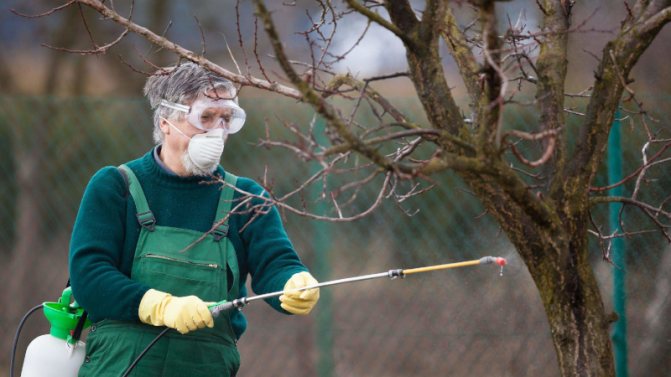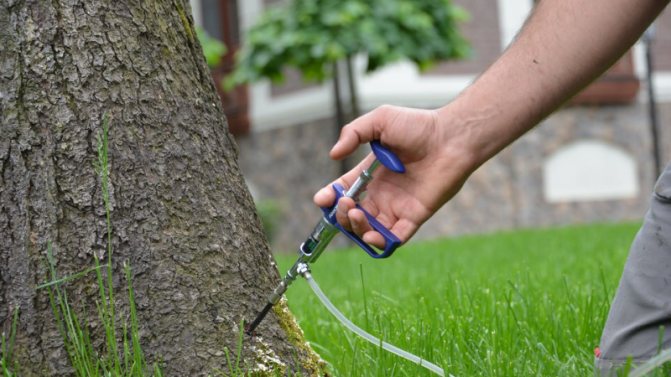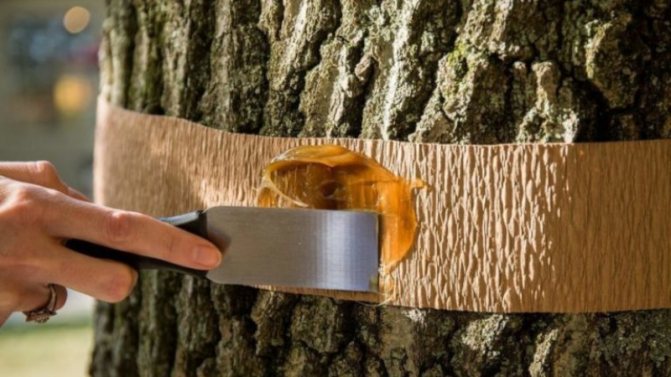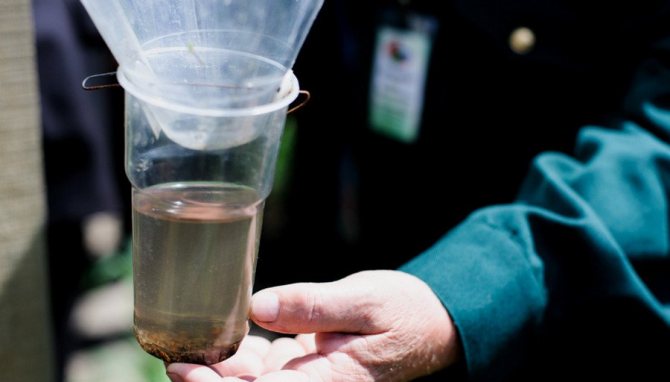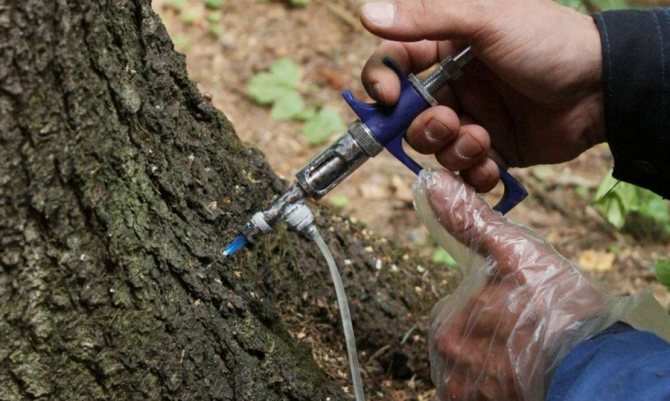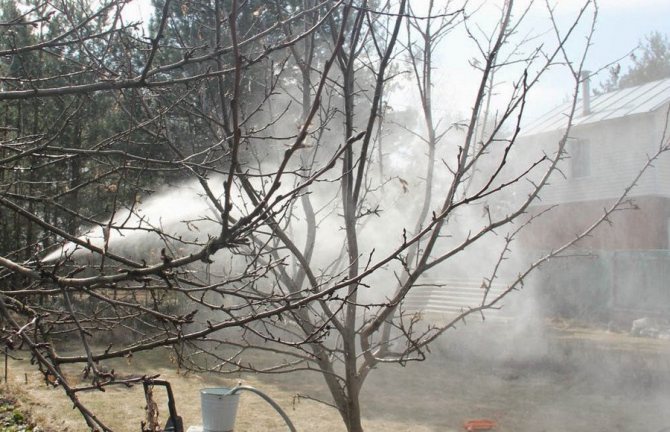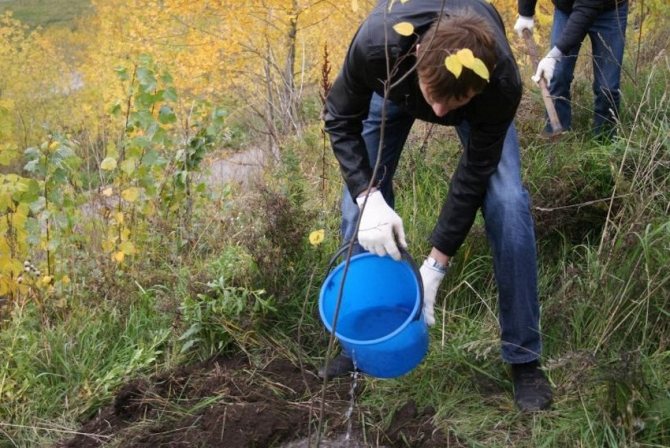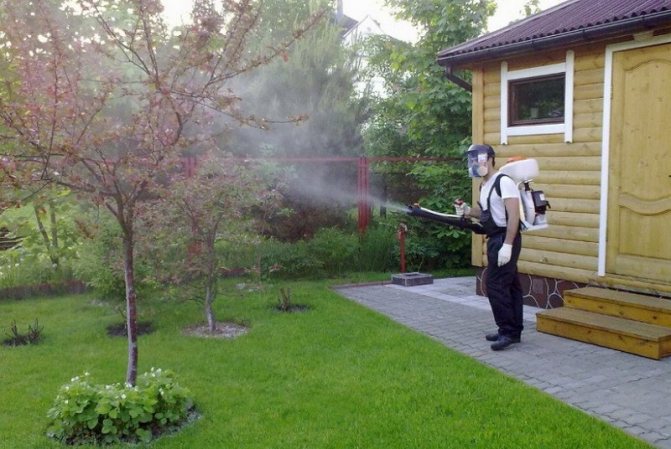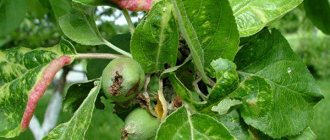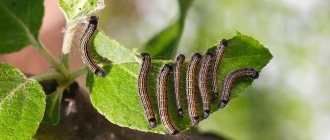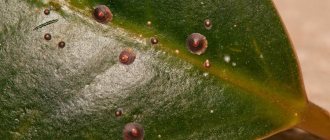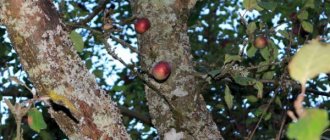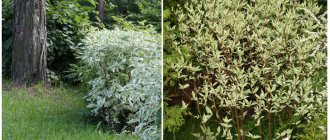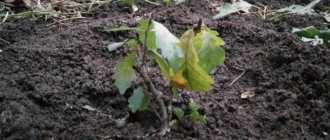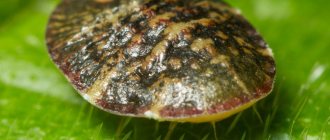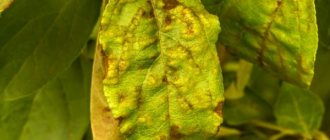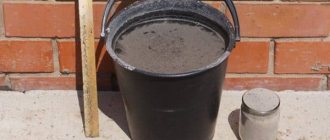»Gardening» Apple tree »How to deal with a bark beetle on an apple tree - advice from gardeners
0
247
Article rating
Fruit trees are often attacked by pests, resulting in less harvest for gardeners, and plants often dying. So, the bark beetle on an apple tree often becomes the reason for its loss, and in the absence of timely measures, the brown sapwood beetle with a striped chitinous shell can destroy the entire orchard.
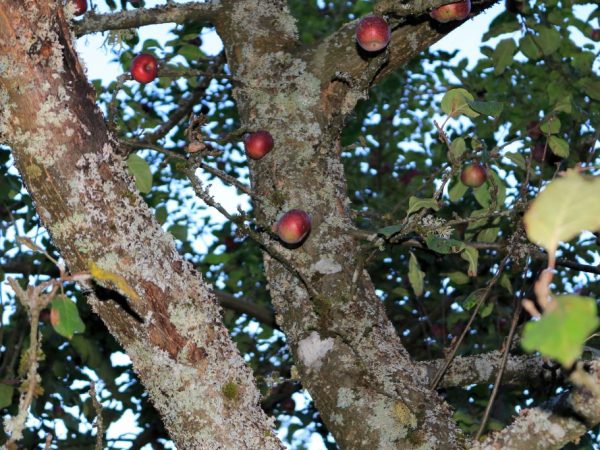
How to deal with a bark beetle on an apple tree - tips from gardeners
Biological characteristics of the apple bark beetle
Apple trees and pears are most often affected by one of the varieties of the bark beetle - the apple tree. Otherwise, it is called fruit sapwood. An adult insect looks like a small dark brown, almost black beetle about 4 mm long. On the hard flaps of this beetle, you can see dotted parallel grooves.
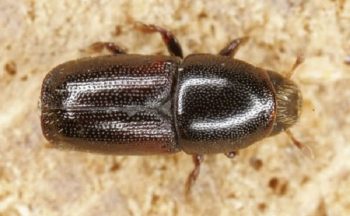

Bark beetles spend almost their entire life inside wood, which complicates the fight against them.
In spring, during the flowering of apple and pear trees, bark beetles begin their flight with the aim of spreading the population and creating new nests. Having chosen a suitable tree, the female gnaws through branched passages through the bark into the depths of the wood. She lays many eggs each turn.
Soon, white, legless and blind larvae, armed with powerful jaws, hatch from the eggs. Their development takes place during the entire growing season exclusively inside the wood. There, the larvae gnaw multiple long passages, feeding on bast and wood. The next spring, the larvae pupate, and by the time of flowering, young beetles emerge from the pupae. Having made their way out with the help of their jaws, they scatter.
Lifestyle, what it eats, features of the life cycle: egg, larva, pupa, adult
Bark beetles pose a great danger to trees for two reasons. Beetles use plants as a food source and shelter for their offspring.
The greatest danger to the tree is represented by the bark beetle larvae, which are especially gluttonous. It is they who make the winding and deep labyrinths under the bark.
The life cycle of an insect consists of 4 stages of development:
- Egg;
- Larva;
- Chrysalis;
- An adult.
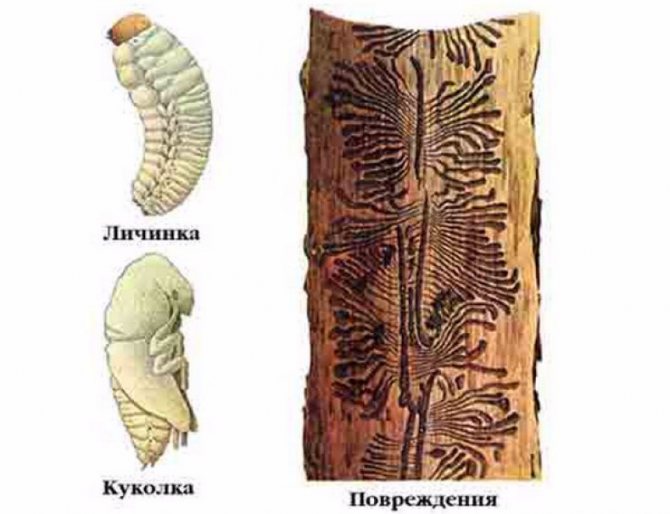

The duration of the stages of insect development:
- Egg stage - 10 to 14 days;
- Larva stage - 15 to 20 days;
- Pupal stage - 10 to 14 days.
The female bark beetle lays eggs in heaps in the juiciest layers of wood - sapwood and bast. A yellowish-white larva with a dark brown head emerges from the egg. She immediately begins to make her own move in the bark of the tree. By eating wood, the larva grows rapidly, and its course in wood becomes wider and wider. After 15-20 days, the larva turns into a pupa.
REFERENCE: If the pupa does not have time to become an adult by the end of summer, it remains to winter in the bark of the tree.
Under favorable weather conditions, several generations of adult beetles can be born in one summer.
Fighting bark beetle using spraying
Fighting the apple bark beetle, given its lifestyle, is a difficult task. If you suspect that pests have settled on trees, a good systemic insecticide should be applied.
Read the article on choosing a sprayer
Systemic insecticides are distinguished by the fact that they penetrate deeply into plant tissues. It is advisable to use them against bark beetles only after the end of flowering, when the beetles begin to fly.... According to gardeners, the following drugs give a good effect:
| Drug name | Benefits | disadvantages |
| "Confidor Extra" | Resistant to washing off and high temperatures, prolonged action, effective against hiding insects. | Toxic to pollinating insects and humans. |
| "Calypso" | Prolonged action, fast effect (after a few hours). | Toxic to pollinators and humans. |
| "Pirinex" | Effective against all life forms of the beetle - eggs, larvae, adults. Resistant to washing off and high temperatures. | Toxic to pollinators and humans. |
| "Arrivo" | The action is contact and systemic, prolonged. High efficiency. | Toxic to humans and pollinators. |
| "Bitoxibacillin" | Safe for humans and bees. Does not accumulate in fruits. Highly effective against larvae and adult insects. | Does not affect bark beetle eggs. Requires multiple treatments. |
All branches and trunks of apple trees, pears and neighboring fruit trees are abundantly sprayed with solutions of insecticides on the bark. Re-treatment is carried out after 2 weeks.
Confidor Extra - features and application
Means "Confidor Extra" is a line of new generation preparations designed to combat various types of insects, including the bark beetle, from which the leaves on the trees wither and the fruits disappear.
The drug is produced in Germany, sold in the form of water-dispersion granules in a base with an active component - imidacloprid. The product is packaged in convenient 400 g bottles.
The product is not toxic, therefore it does not pose a danger to people and pets. But, as for the harm to crops on the site, not everything is so smooth here. The drug is classified as hazard class 1 for beneficial microorganisms, therefore, when processing trees, it is recommended to use protective materials.
Confidor Extra works for several weeks, it allows to destroy larvae and adult beetles. The drug is considered universal, therefore it is suitable for combating a number of harmful insects in the open field.
Remedies for spraying the garden with insecticides
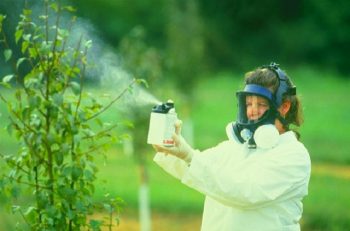

Spraying the garden with pesticides is permissible only in cloudy, calm weather.
Gardeners often have to use chemicals, including those with a high hazard class. Therefore, it is advisable to have personal protective equipment in your arsenal:
- respirator;
- mask or goggles;
- special clothing;
- gloves.
It is better to purchase a gas and dust respirator in order to reliably protect against accidental inhalation of both powders when preparing mixtures and aerosols themselves when spraying.
Well proven respirators of the "3M" trademark... Particularly popular is the 3M 9300 series - compact folding models that do not restrict the view and are softly fixed on the face. Another decent option – respirator "Astra-2"... Unlike the 3M models, it has a rigid rubber structure, however, it is no less convenient to use and perfectly filters aerosols of any degree of dispersion.
Fighting bark beetles with traps and repellents


A harmless and effective way to scare away the bark beetle is to use ultrasonic scarers during the flight.
An additional method of protecting the garden from bark beetles is to catch insects during the flight. In amateur gardening, wooden traps are most often used. For example, after pruning apple trees, the branches are not disposed of, but folded at a distance from the site.
The meaning of this procedure is simple: bark beetles in search of a new home are guided by smell. The smell of a sawn tree attracts insects, and they land not on living plants, but on dead wood. When the flight of beetles ends (after about 3-4 weeks), this deadwood is burned.
Special antiferomone bark beetle repellents also show high efficiency. These are tablets impregnated with substances unpleasant for the smell of insects. It is enough to hang scarers on the branches of apple and pear trees a week before the mass flight to ward off bark beetles from the garden for a long time. The advantage of this product is that it is absolutely harmless to people and the environment. You can buy repellents, for example, in fruit tree nurseries.
Tip # 2. It is better not to use pheromone traps, unlike scarers, in private gardens - you can lose all the trees. Pheromones are used only on areas of at least 5 hectares.
Summing up
The appearance of a bark beetle in an apple orchard can result in the death of trees. When the first signs of infection of a fruit crop with a parasite are found, it is worth immediately starting treatment with the use of pesticides.
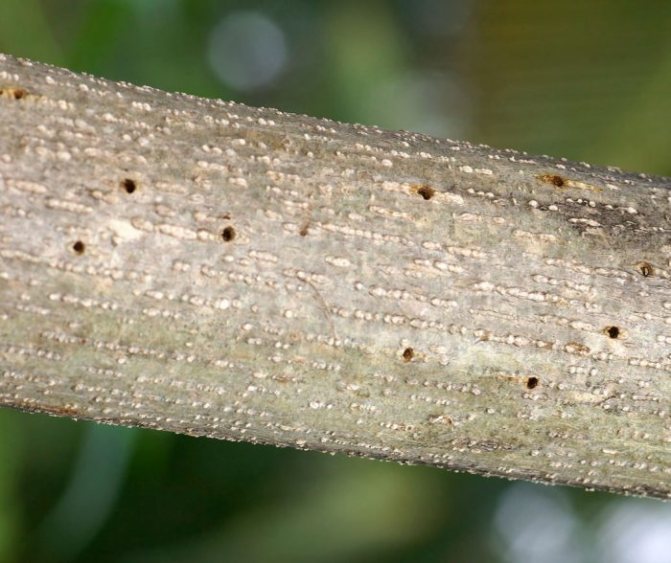

The bark beetle (Scolytinae) belongs to the subfamily of beetles, the Weevil family. In total, there are 750 species of bark beetles, with 140 of them belonging to the European fauna. The size of such a beetle can vary from 8 to 15 mm. For a summer cottage, the bark beetle is a very dangerous pest that can destroy trees of any age, as well as severely damage wooden buildings. The recent climate change has become the reason for the mass reproduction of the bark beetle.
Syringing as a method of combating bark beetle on apple and pear trees
The described remedies are effective against the bark beetle only as long as it has not penetrated deep into the plant tissue. If the pest managed to penetrate deep into the wood, it is necessary to deal with it by another method - extrusion of the trunk. It is customary to call injection of drugs into the flight holes of bark beetles. For this, a conventional medical syringe and one of the following insecticides are used:
| A drug | Mode of application |
| "Confidor Maxi" | Dilute 0.1 ml of the emulsion in 100 ml of water. Collect the solution into a syringe and inject it into the flight holes of the bark beetles. |
| "Tanrek" | Dilute 0.3 ml in 100 ml of water. Collect the required amount of solution into a syringe and inject it into the flight holes. gardeners' reviews about Tanrek |
| "Calypso" | Dilute 0.1 ml in 100 ml of water. Introduce the solution into the flight holes. |
The concentration of drugs when injecting is quite high, but, unfortunately, otherwise it is difficult to etch the beetle out of the tree trunk. After the introduction of insecticides, it is recommended to cover the holes with garden pitch.
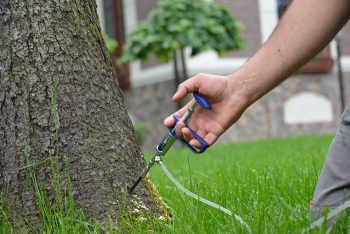

For the treatment of valuable varieties of apple and pear trees, it is better to order a professional intra-trunk injection.
Stimulation of the immune system of apple and pear trees to protect against bark beetle
Bark beetles, like other insect pests, never infect a strong tree. A healthy apple or pear has strong wood, and the insect is looking for where it can settle its offspring so that it would be easier for it to survive. Consequently, an important measure to protect the garden from the bark beetle is to increase the immunity of fruit crops.
For the immunization of apples and pears, stimulants and fertilizers are used:
| Name | Purpose of application | Mode of application |
| "NV-101" | Activating the immune system, improving the quality of photosynthesis. | Spread the granules in a circle around the trunk, lightly embed them in the soil and water. Dilute 1 ml of the liquid preparation in 10 liters of water and spray the apple trees after flowering for 3 weeks, once a week. |
| "Rich-Micro with Zinc and Copper" | Saturation of tissues with microelements, increasing resistance to diseases and pests. | Dilute 1 tablespoon in 10 liters of water and carry out foliar feeding at the beginning of the growing season for 4 weeks, once a week. |
| "Gumi-30 Universal" | Increasing stress resistance of trees to external influences. Increase immunity to diseases, saturation of tissues with mineral elements, stimulation of growth. | Dilute 100 g of paste in 200 ml of water.Add the working solution to the irrigation water at the rate of 1 tablespoon per 10 liters of water. Water once every 2 weeks. |
Phosphorus-potassium fertilizers also increase the resistance of apples and pears to unfavorable environmental factors. These include, for example, "Diammofoska", which must be embedded in the trunk circle at the rate of a tablespoon per 1 m2.
Vitalizer NV-101 - a proven remedy for pests
Vitalizer NV-101 is a complex designed to combat a number of pests and diseases of fruit trees, while contributing to their active growth. The drug is produced in liquid form and in the form of granules, packaged in containers of different volumes. It is based on active extracts from pine, cedar, cypress and plantain. Helps protect trees from:
- harmful beetles;
- larvae;
- caterpillars;
- bacteria and fungi.
The obvious advantage of the drug is zero toxicity. This means that it will be possible to get rid of the bark beetle without any risk of infecting trees, poisoning bees or harming the development of microorganisms in the soil.
Garden bark beetle control plan
Treatment of apple and pear trees infected with bark beetle and preventive work can be carried out according to the following approximate plan:
| Event duration | Event |
| Spring, before the kidneys awaken |
|
| Phase of the extension of the "green cone" |
|
| The phase of the extension of inflorescences |
|
| After flowering |
|
| If a bark beetle is found |
|
| After falling leaves |
|
Prevention of the appearance of a bark beetle in the garden
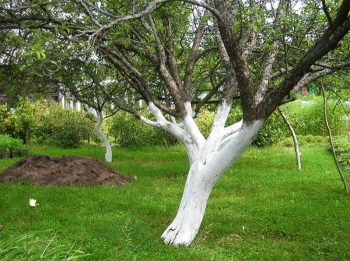

Whitewashed trees are less likely to be affected by the bark beetle.
If a bark beetle started up on apple trees or pears, the gardener could have made the following mistakes:
- Improper care of the trunk of trees. Cracks in the bark, frost holes, poorly processed cuts - all these are open doors for the pest.
- Improper crown care. Dried or diseased branches emit a smell that attracts bark beetles.
- Improper care of the near-stem circle. Fallen branches left under the tree can be infected with pest eggs. Next spring, young beetles will emerge from this litter.
To avoid the invasion of bark beetles on your garden, you need to take a number of preventive measures:
- Timely peel and shape the crown of apple and pear trees.
- Remove dead wood, stumps, cut branches from the garden.
- Carry out preventive spraying with insecticides after the end of flowering of apples and pears.
- Grub up and burn trees heavily affected by the bark beetle.
- Adjust the mode of irrigation and feeding of apple and pear trees.
- Whitewash the trunks and skeletal branches of trees.
- Keep the trunk circles clean.
- In case of mass destruction of all surrounding gardens by the bark beetle, it is advisable to seek help from a specialized organization that takes care of trees.
The first signs of damage on a tree
Often, gardeners detect the appearance of a bark beetle even when the degree of damage is already very high, and more specifically, when the bark leaves in whole layers. Most often, in such a situation, nothing will help the tree, it will only be necessary to cut it down. That is why it is necessary to know what signs may be evidence of the appearance of a bark beetle on apple trees. Among them:
- small holes in the bark;
- the appearance of light sawdust or wood flour, evidence of the activity of the bark beetle;
- partial cessation of the development of shoots;
- the settlement of a woodpecker on a tree, because he very much loves to feast on this pest.


Sign of damage to the apple tree by the bark beetle.
The degree of damage can be understood by the color of flour, sawdust, which can be found near the holes. Brown color means that the pest has just appeared and is still acting in the bark, and white means that the process has already gone deep into the trunk.


